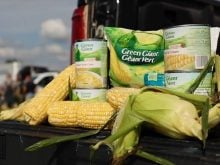A $240 million increase to the Feeder Cattle Loan Guarantee program will help strengthen Ontario’s beef sector.
The increase doubles the loan program’s scope to $500 million in low-interest finance to support short-term needs and long-term growth of feeder cattle co-operatives and their members.
Why it matters:
Read Also

Defence investments could benefit agriculture
A bump in Canada’s NATO spending commitments could lead to infrastructure investments that would benefit rural areas
Increased funding for the guaranteed loans provides sector stability and opportunities for existing and young farmers while new marketing dollars build demand.
“Increasing the government guarantee and the individual loan limits under the Ontario Feeder Cattle Loan Guarantee Program will allow the program to better respond to the escalation in cattle prices,” said Craig McLaughlin, Beef Farmers of Ontario (BFO) president. “And growing interest from young and beginning farmers, as well as existing farmers, who value the program for its reliable access to affordable credit.”
The funding announcement was made July 29 at Henrydale Farms, a fourth-generation dairy and budding beef operation in Carleton Place owned by Kurtis and Rachel McCrae. Ontario Minister of Agriculture, Food and Agribusiness Rob Flack said the McCrae’s are the perfect example of producers who could benefit from the program expansion.
Flack said the young couple told him they went from paying $1,000 per stocker three years ago to $1,900 this year, and next year’s payment could be more.
“These farmers need support,” said Flack. “It also supports succession plans on certain farms and enables young farmers to get into the business of farming.”
Flack explained that, like the McCraes, 41 per cent of Feeder Cattle Loan Guarantee Program members are under 40 years old. Young or new farmers haven’t amassed the credit standing most financial institutions require.
The program provides low-interest loans to producers, with the province providing the same financial assurance as a parent co-signing a lease for their post-secondary-bound child.
“It’s a hand up, not a handout,” McLaughlin said.
Flack said Ontario’s 12,000 beef producers are strong, innovative, and progressive, and the sector represents just shy of $2 billion in on-farm cash receipts.
He added that in 30 years, the government has never had to cover a loan.
Adjustments to the administration of the program now allow funding allocations to be easily transferred from fully subscribed co-ops and dispersed to other co-ops, creating a fast and flexible process.
Additionally, the government pledged $2 million over four years to the Ontario Beef Marketing Development program to strengthen competitiveness and support provincial and international trade shows and missions for potential out-of-market buyers to tour Ontario beef farms and processors.
“The more sustainable our producers are, the more likely people are going to consider investing in further processing to help enhance not only our industry but look for international markets,” said Flack.
The provincial government’s job is to maximize market growth by creating an environment that attracts increased investment, whether by opening export markets or building increased processing.
“Because together everybody achieves more, the better beef raised by our farmers, the stronger our processing sectors are,” he said. “The better we’re going to be able to attract export markets and share the goodness of Ontario beef.”
McLaughlin said that while new barns are being built and the Ontario feeder cattle sector is growing slowly, he isn’t sure that equates to more animals.
“Due to better genetics, feeding programs, and nutrition, we get animals to market quicker,” he explained. “They have more meat, and we’ve learned, over the years, to get more value out of the carcass, so you can do a lot more with less cattle.”
In the last five years, John Baker, Ontario Beef Marketing Development program director, said there’s been heavy investment in industry-led initiatives to grow domestic and export markets for Ontario-branded beef, maximize its value and share the industry’s sustainability story. “We have an outstanding product and are well-positioned to increase market share of Ontario beef in many key global markets,” said Baker. “This investment will help augment our market development efforts both domestically and internationally.”















